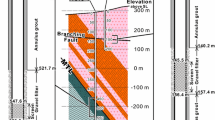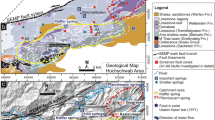Abstract
Fault rocks that occur in the Yugye segment of the Yangsan fault zone, South Korea, are classified based on information from geological field and drilling surveys, including total core recovery, rock quality designation, particle size distribution analysis, characterization of fault rocks intersected in boreholes, and hydraulic conductivity values established from Lugeon tests. The classification assigns fault rocks to three categories, i.e., fault damage zone, fault breccia, or fault gouge, with average hydraulic conductivities of 1.22 × 10−6, 2.07 × 10−4, and 2.57 × 10−5 cm/s, respectively. The hydraulic conductivity of the sedimentary host rock is 2.76 × 10−6 cm/s, similar to that of the fault damage zones, which suggests that the multiple fractures in the fault damage zones are closed in situ. The hydraulic conductivity of the fault core (fault breccia and fault gouge) is greater than that of the fault damage zones and host rocks by one or two orders of magnitude. In addition, the permeability of the fault breccia is greater than that of the fault gouge, which contains more clay. The hydraulic conductivity of both the fault breccia and fault gouge show a positive correlation (R2 ≥ 97%) with increasing fragment content.















Similar content being viewed by others
Data availability
Some or all data, models, or code that support the findings of this study are available from the corresponding author upon reasonable request.
References
ASTM D1140–17 (2017) Standard test method for determining the amount of material finer than 75-μm (No. 200) sieve in soils by washing. ASTM International, West Conshohocken, PA. https://doi.org/10.1520/D1140-17
ASTM D2487–17 (2017) Practice for classification of soils for engineering purposes (Unified Soil Classification System) ASTM International, West Conshohocken, PA. https://doi.org/10.1520/D2487-17
ASTM D422–63 (2007) Standard test method for particle-size analysis of soils ASTM International, West Conshohocken, PA 2007. https://doi.org/10.1520/D0422-63R07E02
Bense VF, Gleeson T, Loveless SE, Bour O, Scibek J (2013) Fault zone hydrogeology. Earth Sci Rev 127:171–192
Bicocchi G, Ambrosio MD, Vannocci P, Nocentini M, Tacconi-Stefanelli C, Masi EB, Carnicelli S, Tofani V, Catani F (2015) Preliminary assessment of the factors controlling the geotechnical and hydrological properties in the hillslope deposits of Eastern Tuscany (Central Italy). IAMG 2015 Proceedings: G0706
Bieniawski Z (1974) Geomechanics Classification of Rock Masses and Its Application in Tunneling. Int J Rock Mech 2. Part A: 27–32
Blenkinsop TG (2000) Deformation microstructures and mechanisms in minerals and rocks. Kluwer Academic Publishers Dordrecht 978-0-412-73480-9
Caine JS, Evans JP, Forster CB (1996) Fault zone architecture and permeability structure. Geology 24(11):1025–1028
Cavailhes T, Sizun JP, Labaume P, Chauvet A, Buatier M, Soliva R, Mezri L, Charpentier D, Leclere H, Trave A, Gout C (2013) Influence of fault rock foliation on fault zone permeability: the case of deeply buried arkosic sandstones (Grés d’Annot, SE France). AAPG Bull.: 97 (7), 1521–1543
Chang KH, Woo BG, Lee JH, Park SO, Yao A (1990) Cretaceous and early Cenozoic stratigraphy and history of eastern Kyongsang Basin, S. Korea. Journal of Geological Society of Korea 26:471–487
Chester FM, Logan JM (1986) Implications for mechanical properties of brittle faults from observations of the Punchbowl Fault Zone, California. Pure Appl Geophys 124:79–106
Clark C, James P (2003) Hydrothermal brecciation due to fluid pressure fluctuations: Examples from the Olary Domain, South Australia. Tectonophysics 366:187–206
Cornelis K, Anthony P (2016) Igneous Rock-forming Minerals. Earth Materials 2nd Edition, Cambridge University Press: 159–196
Deere DU (1963) Technical Description of Rock Cores for Engineering Purposes. Rock Mechanics and Engineering Geology 1(1):16–22
Faulkner DR, Lewis AC, Rutter EH (2003) On the internal structure and mechanics of large strike-slip fault zones: Field observations of the Carboneras fault in southeastern Spain. Tectonophysics 367(3–4):235–251
Farrell NJC, Debenham N, Wilson L, Wilson MJ, Healy D, King RC, Holford SP, Taylor CW (2021) The effect of authigenic clays on fault zone permeability. JGR Solid Earth 126(10): e2021JB022615
Farrell NJC, Healy D (2017) Anisotropic pore fabrics in faulted porous sandstones. J Struct Geol 104:125–141
Farrell NJC, Healy D, Taylor CW (2014) Anisotropy of permeability in faulted porous sandstones. J Struct Geol 63:50–67
Ferraro F, Agosta F, Ukar E, Grieco DS, Cavalcante F, Belviso C, Prosser G (2019) Structural diagenesis of carbonate fault rocks exhumed from shallow crustal depths: an example from the central-southern Apennines, Italy. J Struct Geol 122:58–80
Geological survey of Korea (1968) Explanatory text of the geological map of Cheongha sheet (1:50,000). 16
Gudmundsson A (2004) Effects of Yong’s modulus on fault displacement. CR Geosci 336:85–92
Hwang BH, Lee JD, Yang K (2004) Petrological study of the granitic rocks around the Yangsan fault: Lateral displacement of the Yangsan fault. J Geol Soc Korea 40:161–178
Hwang BH, Lee JD, Yang K, McWilliams M (2007) Cenozoic strike-slip displacement along the Yangsan fault, southeast Korean Peninsula. Int Geol Rev 49:768–775
Higgins MW (1971) Cataclastic rocks. U.S. Geological Survey Professional, Paper 687: 97
Houlsby AC (1976) Routine interpretation of the Lugeon water test. Q J Eng GeolHydrogeol 9:303–313
Ingebritsen SE (2010) Manning. Permeability of the Continental Crust: Dynamic Variations Inferred from Seismicity and Metamorphism 10:193–205
Ingebritsen SE, Manga M (2019) Earthquake Hydrogeology. Water Resour Res 55(7):5212–5216
Kaproth BM, Kacewicz M, Muhuri S, Marone C (2016) Permeability and frictional properties of halite-clay-quartz faults in marine-sediment: The role of compaction and shear. Mar Pet Geol 78:222–235
Killick AM (2003) Fault rock classification: An aid to structural interpretation in mine and exploration geology. S Afr J Geol 106:395–402
Kyung JB, Chang TW (2001) The latest fault movement on the Northern Yangsan Fault zone around the Yugye-Ri area, Southeast Korea. J Geol Soc Korea 37(4):563–577
Kim MC, Jung SH, Yoon SW, Jeong RY, Song CW, Son M (2016) Neotectonic crustal deformation and current stress field in the Korean Peninsula and Their tectonic implications: A review. Jour Petrol Soc Korea 25(3):169–193
Kim YS, Jin KM (2006) Estimated earthquake magnitude from the Yugye Fault displacement on a trench section in Pohang, SE Korea. J Geol Soc Korea 42(1):79–94
KRC (Korea Rural Community Corporation) (1999a) Plan supplementation documents for the rural water development project. Report (in Korean)
KRC (Korea Rural Community Corporation) (1999b) Folders for the technical documents of the Cheongha region. Report (in Korean)
KRC (Korea Rural Community Corporation) (1999c) The rural water development project of Cheongha region. Report (in Korean)
KRC (Korea Rural Community Corporation) (2001) Practical guidelines for dam grouting design and construction. Report (in Korean)
KRC (Korea Rural Community Corporation) (2004) Implementation plan change documents for the rural water development project. Report (in Korean)
KRC (Korea Rural Community Corporation) (2020) Practical data for foundation treatment (grouting) construction. Report (in Korean)
KSEG (Korean Society of Engineering Geology) (2021) Precision investigation service of Yugye region. Report (in Korean)
Lin A, Yamashita K (2013) Spatial variations in damage zone width along strike-slip faults: And example from active faults in southwest Japan. J Struct Geol 57:1–15
Matsumoto N, Shigematsu N (2018) In-situ permeability of fault zones estimated by hydraulic tests and continuous groundwater-pressure observations, Earth. Planets and Space 70:13
Mayolle S, Soliva R, Caniven Y, Wibberley C, Ballas G, Milesi G, Dominguez S (2019) Scaling of fault damage zones in carbonate rocks. J Struct Geol 124:35–50
Miller SA, Collettini C, Chiaraluce L, Cocco M, Barchi M, Kaus BJP (2004) Aftershocks driven by a high pressure CO2 source at depth. Nature 427:724–727
Mohamdally M, Soroush M, Zeidouni M, Alexander D, Boodlal D (2018) Fault leakage assessment using the capacitance model. Society of Petroleum Engineers In: SPE Trinidad and Tobago Section Energy Resources Conference 2018
Rempe M, Mitchell TM, Renner J, Smith SAF, Bistacchi A, Di Toro G (2018) The relationship between microfracture damage and the physical properties of fault-related rocks: The Gole Larghe Fault Zone, Italian Southern Alps. Journal of Geophysical Research: Solid Earth 123:7661–7687
Scibek J, Gleeson T, McKenzie JM (2016) The biases and trends in fault zone hydrogeology conceptual models: global compilation and categorical data analysis. Geofluids 16(4):782–798
Scibek J (2020) Multidisciplinary database of permeability of fault zones and surrounding protolith rocks at world-wide sites. Scientific Data 7(95):14
Shi Z, Wang G (2014) Hydrological response to multiple large distant earthquakes in the Mile well, China. J Geophys Res Earth Surf 119(11):2448–2459
Sibson RH (1977) Fault rocks and fault mechanisms. J Geol Soc 133:191–213
Snoke AW, Tullis J, Todd VR (1998) Fault-related rocks. A Photographic Atlas – Princeton: Princeton University Press: 617
Toy VG, Boulton CJ, Sutherland R, Townend J, Norris RJ, Little TA, Prior DJ, Mariani E, Faulkner D, Menzies CD, Scott H, Carpenter BM (2015) Fault rock lithologies and architecture of the central Alpine fault, New Zealand, revealed by DFDP-1 drilling. Lithosphere 7(2):155–173
Twiss RJ, Moores EM (1992) Structural geology. W.H. Freeman and Company New York: 532
Vrolijk PJ, Urai JL, Kettermann M (2016) Clay smear: review of mechanisms and applications. J Struct Geol 86:95–152
Wang CY, Liao X, Wang LP, Wang CH, Manga M (2016) Large earthquakes create vertical permeability by breaching aquitards. Water Resour Res 52(8):5923–5937
Woodcock NH, Mort K (2008) Classification of fault breccias and related fault rocks. Geol Mag 145(3):435–440
Worden RH, Griffiths J, Wooldrige LJ, Utley JEP, Lawan AY, Muhammed DD (2020) Chlorite in sandstones. Earth-Sci Rev 204:103105
Yielding G, Bretan P, Freeman B (2010) Fault seal calibration: a brief review. Geol Soc Spec Pub 347:243–255
Acknowledgements
This work was supported by the National Research Foundation of Korea (NRF) grant funded by the Korea government (MSIT) (No. 2021R1F1A1061133).
Author information
Authors and Affiliations
Corresponding author
Ethics declarations
Conflict of interest
The authors declare no competing interests.
Rights and permissions
Springer Nature or its licensor holds exclusive rights to this article under a publishing agreement with the author(s) or other rightsholder(s); author self-archiving of the accepted manuscript version of this article is solely governed by the terms of such publishing agreement and applicable law.
About this article
Cite this article
Moon, SW., Kim, HS. & Seo, YS. Relationship between hydraulic conductivity and occurrence of fault rocks in Yangsan fault zone, Korea. Bull Eng Geol Environ 81, 365 (2022). https://doi.org/10.1007/s10064-022-02875-w
Received:
Accepted:
Published:
DOI: https://doi.org/10.1007/s10064-022-02875-w




